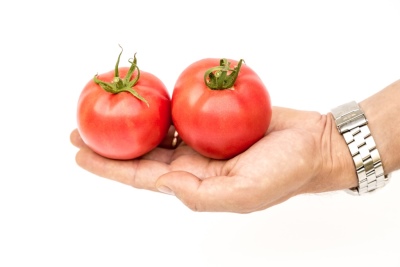
- Authors: Kiramov O.D. (originator - Blokin-Mechtalin V.I.)
- Year of approval: 2017
- Category: hybrid
- Growth type: determinant
- Appointment: fresh consumption
- Ripening period: early
- Ripening time, days: 85
- Growing conditions: for open ground, for film greenhouses
- Transportability: high
- Bush height, cm: 80-90
Every year, new varieties of plants enter the domestic market. And it is almost impossible to deal with them without referring to reference information. Now it's the turn to get acquainted with the tomato Imperial weakness.
Breeding history
The developer of culture is O.D. Kiramov. Another well-known breeder, Blokin-Mechtalin, became the originator. The official permission for consumer cultivation of the variety was issued in 2017.
Description of the variety
Imperial weakness is one of the decent determinant hybrids of the last generation. The plant is positioned as suitable for both open land and a film greenhouse. The choice between these growing options is determined by the characteristics of the terrain and the development of the actual weather. The bushes reach a height of 0.8-0.9 m. Short green foliage is formed on them.
The main qualities of the fruit
The earliest fruits of Imperial Weakness are light green in color. When they are ripe, they will turn pink. It is impossible to find any spots near the stalk. The average weight of a single berry is 150 g. The shape, like many other tomatoes, is round.
The ribs are not very visible. The fruits grow on simple inflorescences. The very first of them is laid over 6-7 sheets. Then they will appear after 1 sheet. The berries of this variety are distinguished by their attractive lightness.
Taste characteristics
Imperial weakness is sweet. Light sourness is mixed with the main taste. She does not leave an unpleasant impression. The pulp is moderately firm. The skin also does not affect the unpleasant sensations.
Ripening and fruiting
This is one of the earliest varieties. It is stated that, on average, with the normal development of the bush, it is possible to harvest the crop 85 days after the greens have ripened. It will be possible to harvest the fruits in July, August and September. Only occasionally does an abrupt change in weather break this established schedule.
Yield
Imperial productivity weakness is by no means weak. It is capable, as the suppliers assure, to give 21 kg of berries per 1 m2. Of course, this can only be achieved with impeccable adherence to agronomic standards.
The timing of planting seedlings and planting in the ground
Sowing seeds in containers should be from January to April. The specific term is chosen at your own discretion. Seedlings are usually ready to be planted in open ground in May or June. The decision must be made based on the readiness of the plants.

Growing tomato seedlings is an extremely important process, because it largely depends on whether the gardener will be able to harvest at all. All aspects must be taken into account, from seedbed preparation to planting in the ground.
Landing scheme
It is chosen taking into account the growing conditions. In open gardens for 1 sq.m 5 bushes can be used. If the tomato is grown in greenhouses, then it is necessary to plant 3 plants on 1 "square". Accordingly, seating systems are used - 700x300 and 800x400 mm. It is impractical to use other options.

Growing and care
Imperial weakness strongly requires shaping. The culture needs to be formed in 2-3 stems. It is stated that this tomato tolerates the effects of:
late blight;
alternaria;
verticillosis;
fusarium wilting;
tobacco mosaic.
When planting seedlings in a permanent place, it is necessary to feed the wells with ash, superphosphate and potassium phosphate. Together with them, fishmeal is also used. Seedlings are picked when 2-3 true leaves appear. Hardening is carried out in the last 14-20 days before transplanting to a permanent place. But hardening should also happen in a smart way, without any drafts.




A plant needs different micronutrients at each stage of growth. All fertilizers can be divided into two groups: mineral and organic. Folk remedies are often used: iodine, yeast, bird droppings, eggshells.
It is important to observe the rate and period of feeding. This also applies to folk remedies and organic fertilizers.


Growing regions
Imperial weakness will find its rightful place in the beds in:
Western Siberia;
Moscow region;
Samara, Volgograd and other Volga regions;
Sverdlovsk, Kurgan regions and other areas of the Urals;
the center of the Black Earth Region;
northern and northwestern regions of the European part of Russia;
middle lane;
Far Eastern territories and regions, including the Jewish Autonomous Region.
Review overview
Almost all farmers like the Imperial Weakness variety. This plant fully lives up to the entire description. Fruiting is indeed abundant. Even in a difficult summer, the return from the plant is great. Many of those who have tried such bushes in their areas confidently leave them.

























































































